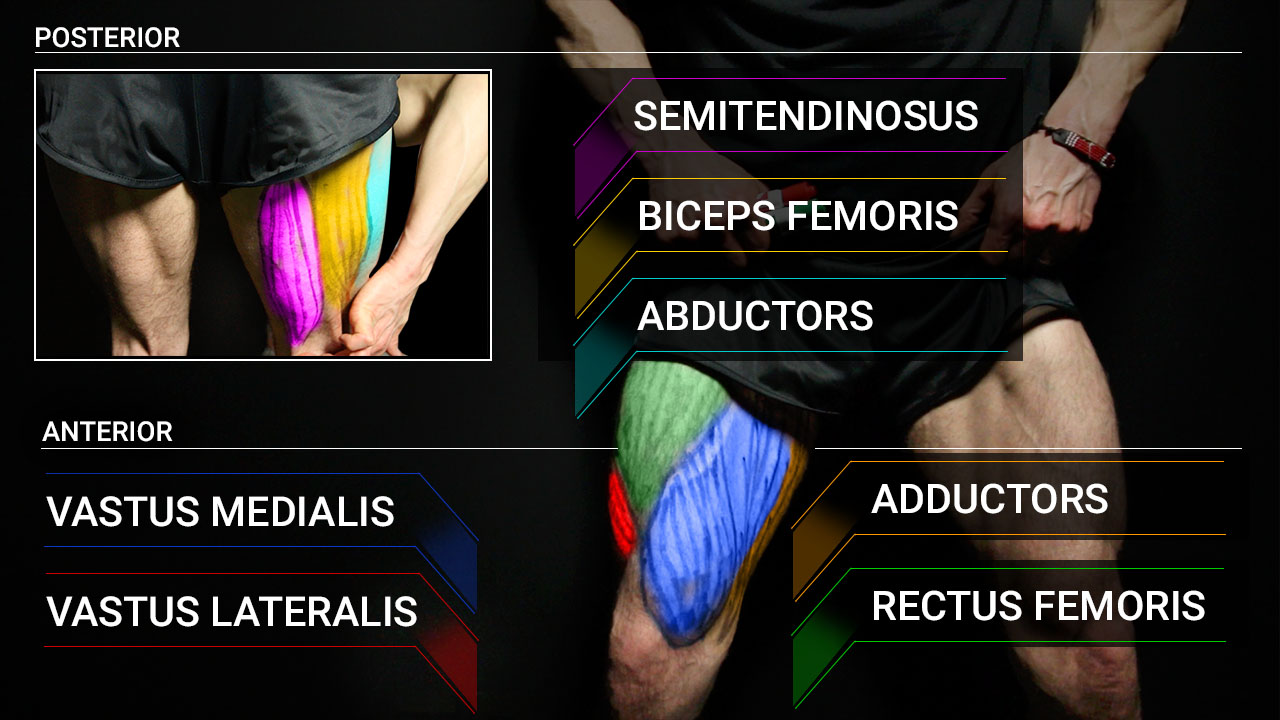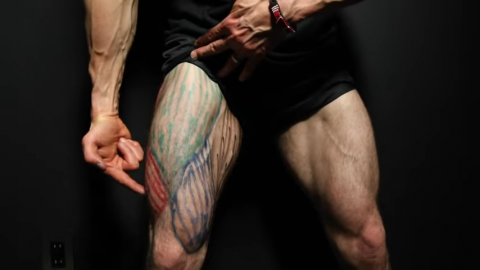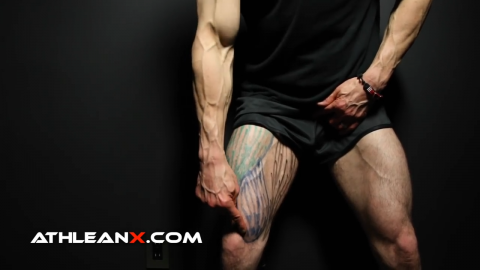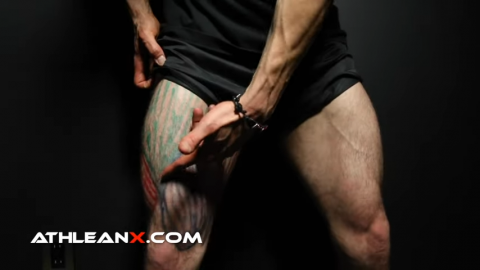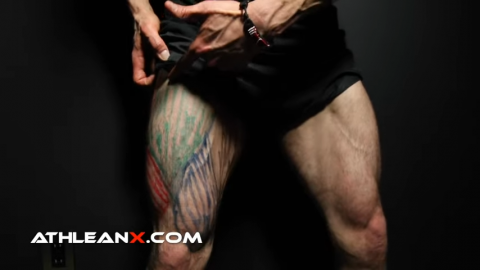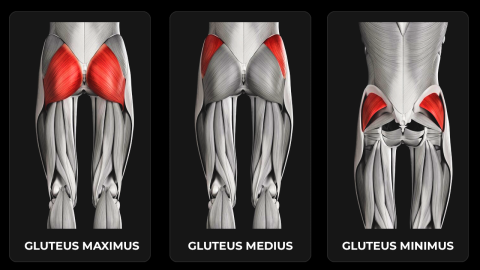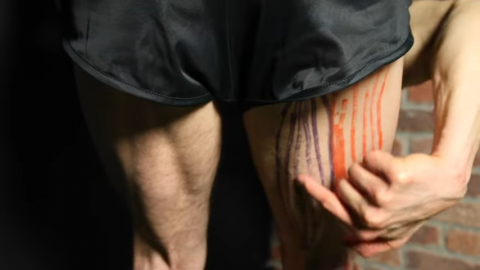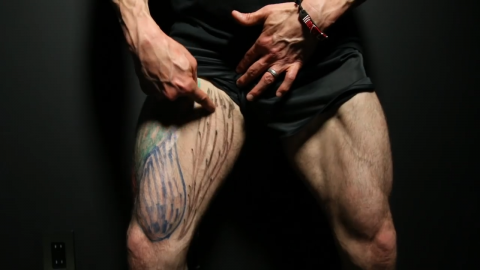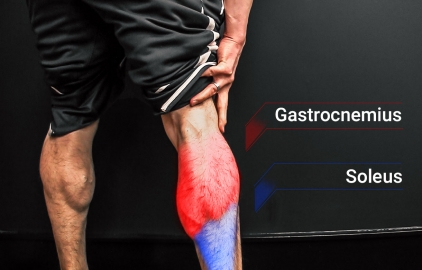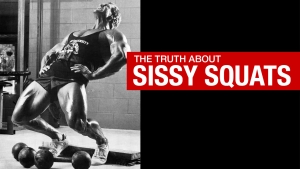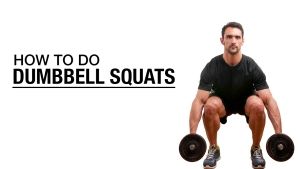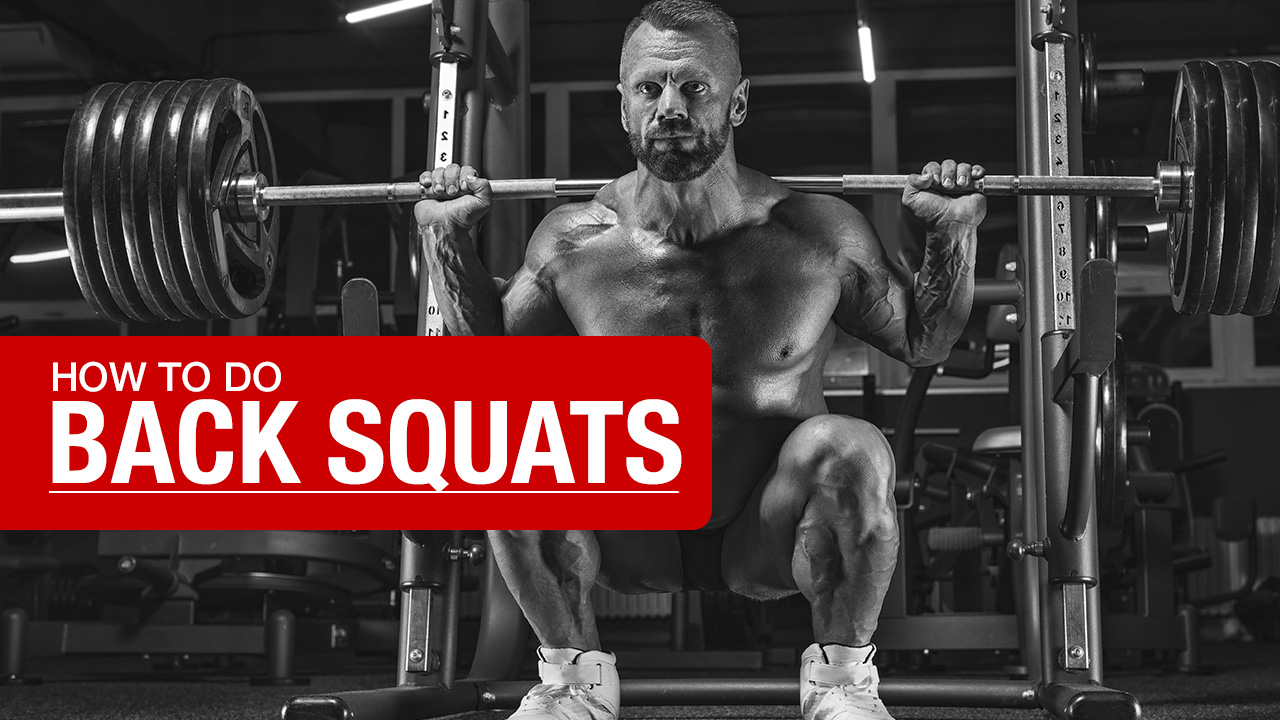
HOW TO MASTER THE BACK SQUAT
Think you’ve mastered the Back Squat?
If you’re like most gym goers, you’re butchering this fantastic whole-body functional lift.
You see, most people let their lower back and shoulders do the heavy lifting in their Squat program instead of their quadriceps and glutes.
Back Squats might seem straightforward—sit down, stand up—but if you’re not engaging the right muscles, you’re not getting the full benefit in your daily movement and exercise routine.
What’s more, you’re setting yourself up for injury during this preferred Squat – that is, with a barbell.
We need to fix this… and fast!
Improper form can lead to imbalances in muscle strength, joint pain, and stalled progress.
Today, we’re breaking down the squat to make sure you’re targeting the right muscles and maximizing your gains.
Let’s get into it and make sure you’re doing it right.
BACK SQUATS: MUSCLES WORKED
To get the most out of your Back Squats, one of the three major competition lifts, you need to master the mind-to-muscle connection.
There is a direct correlation between squats and actively thinking about muscle activation.
It’s not just about moving those iron plates—it’s about knowing and feeling the muscles you’re targeting.
Engaging the right muscles can make all the difference in maximizing your results and minimizing the risk of injury.
Let’s break down the key muscles worked during Back Bar Squats and how to ensure they’re firing on all cylinders with every rep.
QUADRICEPS
Your quads are the biggest musculature in your legs.
They are the prime movers during the Squat exercise, involving four distinct heads that drive your lower body and explosive quad strength.
As far as aesthetic benefits go, Back Squats help to make these four heads pop and become more visible.
VASTUS LATERALIS
Found on the front of your leg, the vastus lateralis is one of the major muscles (and the meaty portion of your thigh) directly targeted in Back Squats.
This muscle supports knee extension and helps you maintain an upright position during squat variations like Barbell Squats, Front Squats, Goblet Squats and Double Rack Squats.
Proper engagement of the vastus lateralis ensures optimal form and minimizes injury risk.
Whether you’re lifting heavy or lighter weights, this muscle stabilizes your knee joint and controls the squat movement, aiding in beneficial exercises such as Deep Squats, Fronts Squats, and various squat stances such as the Bulgarian or rear-foot-elevated Split Squats.
VASTUS MEDIALIS
The vastus medialis is located on the inner front thigh. This major muscle is vital for knee extension and stability, especially under a max load.
Whether you’re hitting Barbell Back Squats, Front Squats, Bulgarian Split Squats, or even exercise bikes in your program, the vastus medialis helps control your knee joint and ensures an optimal squat position, reducing the risk of injury and enhancing your overall performance.
Proper engagement of the vastus medialis also contributes to better trunk stability and allows for a deeper range of motion, which is essential for muscle growth.
VASTUS INTERMEDIUS
Tucked right between the vastus lateralis and vastus medialis, the vastus intermedius kicks off from the front and side of your thigh bone.
It’s involved with knee extension and maintaining an upright posture during heavy compound exercises like the Barbell Back Squat.
When you load up the squat rack and take that deep inhale, the vastus intermedius kicks in to stabilize your knee joint and control the squat movement.
Proper engagement of this muscle ensures optimal form, allowing you to handle heavier weights and achieve greater squat depth during these muscle-strengthening exercises.
RECTUS FEMORIS
The rectus femoris is the only quad muscle that connects above the hip, giving it a unique dual role.
It not only drives knee extension but also helps with power through legs and hip flexion, making it necessary for advanced movements like High Knees and Leg Raises.
Not to mention, it’s important for mastering the Back Squat.
The rectus femoris maintains optimal squat position and form.
Its ability to manage both knee and hip movement ensures that you can handle heavy loads while achieving proper squat depth and range of motion.
GLUTES
Next up, we have the glutes, which drive hip extension and provide stability throughout your posterior chain muscles while improving lower body power during Back Squats.
Back Squats are a phenomenal glute builder so it’s important to understand how the exercise activates this muscle group.
GLUTEUS MAXIMUS
The gluteus maximus makes up most of your butt’s shape and size.
Located at the top of your buttocks, it originates from the back of your hip bone, tailbone, and the very bottom of your spine, stretching down to connect to the side of your thigh bone and a thick band of tissue running down your leg.
During the Back Squat as well as power sports, the gluteus maximus is key for several reasons:
First, it is the main muscle responsible for hip extension, which is essential for standing up from the squat position.
It also assists in lateral rotation of the thigh, which helps stabilize your hip.
And it plays a role in posterior pelvic tilt, maintaining proper posture and reducing lower back strain.
Essentially, this muscle helps provide power output through the squat, helping with building strength and stability throughout the movement.
GLUTEUS MEDIUS
The gluteus medius, located on the outer upper buttock just beneath the gluteus maximus, originates from the side of the hip bone and attaches to the top of the thigh bone.
During a squat, the gluteus medius helps with hip abduction, moving the thigh away from the body’s midline, which is necessary for maintaining balance and stability.
It also assists with both inward and outward rotation of the thigh, depending on the position of the hip and knee.
Additionally, the gluteus medius stabilizes the pelvis during the squat, ensuring you maintain balance and proper form.
GLUTEUS MINIMUS
Despite being the smallest of the glute muscles, the gluteus minimus, located beneath the gluteus medius on your hip’s side, plays an essential role in executing a Back Squat effectively.
This little muscle keeps your hips stable and helps you move smoothly.
It starts from the outer surface of your hip bone and attaches to the greater trochanter of your thigh bone.
During a squat, the gluteus minimus kicks in to move your thigh away from your body’s midline, similar to stepping to the side.
It also helps rotate your thigh inward when your hip is flexed.
Above all, it stabilizes your pelvis, especially during the squat’s descent and ascent, helping your hips stay level and balanced.
HAMSTRINGS
Flip to the back of your legs and you’ll find the hamstrings.
These bad boys are split into two main groups, and they’re essential for explosive strength and stability in your lower body.
BICEPS FEMORIS
Your biceps femoris, originating from the ischial tuberosity and femur, is necessary for knee flexion and hip extension.
It’s essential for explosive movements like Deadlifts and sprints.
Why does this muscle matter for your squat?
Strong biceps femoris muscles enhance your posterior chain strength, supporting your squat depth, and optimal form.
They stabilize the knee joint and maintain control during heavy load exercises.
SEMITENDINOSUS
Just like the biceps femoris, the semitendinosus handles knee flexion and hip extension, stabilizing your pelvis during heavy lifts.
When you load up the squat power rack and take that deep inhale, the semitendinosus kicks in to maintain control and balance.
It ensures optimal form and squat depth, enhancing your posterior chain strength and overall squat performance outcomes.
ADDUCTORS AND ABDUCTORS
Let’s talk about two muscle groups that often get ignored but are important for your Back Squat optimal performance: the adductors and abductors.
ADDUCTORS
The adductors, located on the inner thigh, are essential for hip adduction and play a role in rotation and flexion of the thigh.
Ignoring them can create imbalances and increase your risk of injury.
When you’re in the squat rack, your adductors help stabilize your knees and maintain optimal squat depth.
Strengthening these muscles will improve your overall leg strength, stability, and mobility, enhancing your sports performance and athletic outcomes.
ABDUCTORS
Now, let’s not forget the abductors on the outer thigh. These muscles are necessary for leg stability and mediolateral movement.
Strong abductors are for maintaining balance, especially during single-leg exercises, and for supporting your knee joint during heavy squats.
Weak abductors can lead to poor squat mechanics and increase the risk of injury.
Integrate Lateral Leg Raises and Banded Side Steps into your routine to strengthen these muscles.
Strong abductors will help you control your squat stance, whether you’re going for a wide stance, narrow stance, or any other variation.
CALVES
The calves consist of two major muscles—the gastrocnemius and the soleus—and both are key to a powerful Back Squat.
GASTROCNEMIUS
Think of the gastrocnemius as the showstopper. It’s the big, beefy muscle most people associate with impressive calves. This muscle is crucial for knee flexion and foot plantar flexion, and it plays a big role when you’re driving up from the squat position, especially during heavy load squats.
But here’s the kicker: for truly 3D calves, you can’t just rely on the gastrocnemius. You need to engage its hidden partner.
SOLEUS
Enter the soleus, the muscle lurking behind the gastrocnemius.
It might not get the glory, but it does the heavy lifting.
The soleus is essential for ankle mobility and stability as well as overall leg strength, especially when you’re pushing through deep squats and maintaining proper form.
Building up the soleus helps push the gastrocnemius outward, making your calves look bigger and more defined.
This muscle supports the knee joint and aids in maintaining control during your squat movement patterns, reducing the risk of injury.
ABDOMINALS
When you think about squats, your mind might go straight to legs, but don’t underestimate the power of your abdominal muscles, especially the rectus abdominis, in mastering the Back Squat.
RECTUS ABDOMINIS
The rectus abdominis, that iconic six-pack muscle, is more than just for show.
Running vertically from your rib cage down to your pelvis, this muscle is key for maintaining proper squat form.
It keeps your trunk stable and supports your spine under heavy loads, ensuring that you don’t fold under the weight.
In the Back Squat, your abs work overtime to stabilize your torso.
They counterbalance the weight on your shoulders, helping to maintain an upright position and protect your spine.
This is important for achieving optimal squat depth and range of motion without compromising form.
When you take a deep inhale before descending into the squat, your rectus abdominis engages, providing the isometric strength needed to control the movement.
This ensures that your squat stance remains solid, whether you’re using a wide stance, narrow stance, or any squat variation.
HOW TO DO THE BACK SQUAT: STEP BY STEP
Now that you understand which muscles you’re targeting, let’s dive into one of the best functional exercises that is consistently featured in studies from the International Journal of Exercise Science: the basic squat.
We’ll start with the right way to do it and then tackle a common mistake that can seriously mess up your muscles if you’re not careful.
Here’s a step-by-step breakdown of how to perform the Barbell Back Squat.
Keep in mind that many of these same cues can be used during some Squat variations like the Sumo Squat and Front Squat.
WHERE DOES THE BARBELL GO?

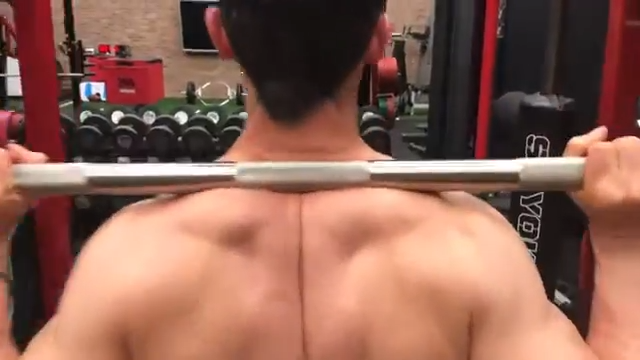
This alignment should be centered over the middle of your foot to keep the load balanced.
If the bar is too far back, you’ll feel like you’re about to tip over—definitely not what you want when squatting.
WHERE DOES YOUR HEAD GO?


Keep your head in a neutral and optimal position—gaze straight ahead, not at the ceiling or floor.
This helps maintain a solid trunk posture and reduces the risk of injury.
HOW TO ANGLE YOUR BACK
Maintain a slight forward lean in your back but keep it straight.
Your thoracic spine should be in an upright position, ensuring your back is strong and stable.
No spinal flexion here!
WHERE DO YOUR KNEES GO?


As you descend, focus on pushing your knees outward for correct knee placement.
They should never collapse inward (a condition known as Knee Valgus).
If this happens, use a resistance band above your knees to train and correct this movement pattern.
WHERE DO YOUR ELBOWS GO?


Keep your elbows tucked in close to your body.
This arm position engages your traps more effectively, helping to maintain the bar position and providing better control over the light weight and progressively heavy weight.
WHERE DOES YOUR CHEST GO?


Channel your inner Superman—chest up and shoulders back.
This chest positioning helps keep your thoracic spine stable and supports the overall squat movement pattern.
WHERE DO YOUR FEET GO?


Your feet should be aligned, with toes slightly pointed out.
Proper foot placement angles are key for stability and effective movement mechanics.
As a quick recap, when you’re ready to squat, ensure everything is in place:
- Bar centered over your feet
- Neutral head position
- Upright trunk
- Proper knee and foot alignment
Start with a lighter weight to master the form, then progressively overload to build strength and muscle.
Remember, perfecting your barbell Back Squat isn’t just about moving heavy weights—it’s about executing the movement with precision to maximize gains and minimize injury risk.
Train smart, stay strong, and keep progressing with every rep.
Putting it all together, here’s how to do heavy weight BB Squats:
BARBELL BACK SQUAT

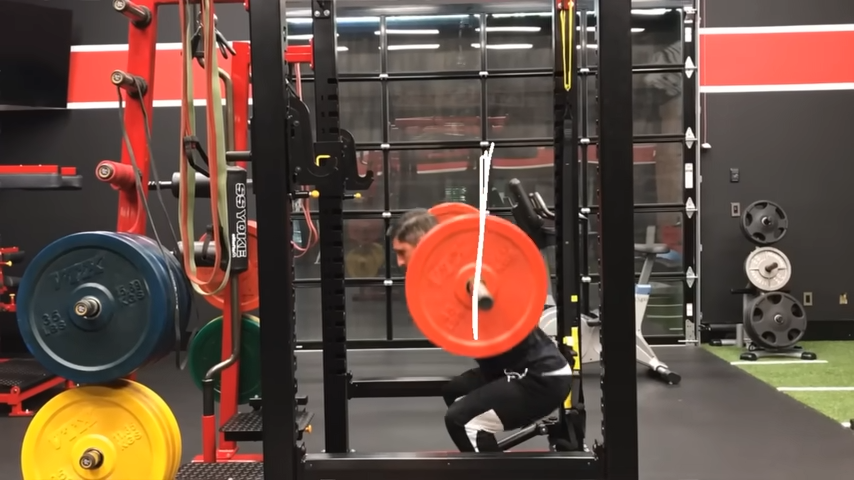
HOW TO DO THE BARBELL BACK SQUAT:
- Step under the barbell and stand with your feet shoulder-width apart.
- Make sure your entire foot is flat on the ground—no lifting your heels or balls of your feet.
- Position the barbell across your traps (upper back muscles), not your neck. Flex your traps to create a comfy shelf for the bar.
- Keep your head in a neutral position—look straight ahead, not up or down.
- Lean slightly forward but keep your back straight and core tight. Your upper back (thoracic spine) should be upright to keep you stable.
- As you lower into the squat, push your knees outward. Avoid letting them collapse inward.
- If your knees tend to cave in, try using a resistance training band around your knees to help train them to stay in position.
- Keep your elbows tucked in close to your body. This helps engage your traps and keeps the bar stable.
- Think “Superman”—chest up, shoulders back. This helps keep your upper back stable and supports the squat movement.
- Make sure your feet are aligned with your toes slightly pointed out. This gives you a solid base and helps with movement mechanics.
- Pause at the bottom of the movement, maintaining core stability, then press through the lower body to return to the initial starting position.
WHAT MAKES IT EFFECTIVE: The heavy Back Squat is an effective exercise because it engages multiple major muscle groups simultaneously, improving overall strength, explosive power, and stability while enhancing fundamental movement patterns.
BACK SQUAT: COMMON MISTAKES
By addressing these common mistakes and focusing on proper form tips, you can tap into the popular benefits of squats including better squat strength, reducing injury risk, and improving overall athletic performance.
Remember, weighted Squats are a fundamental movement that is celebrated by journals such as the Journal of Strength and Conditioning Research.
But, with that said, it also requires a lot of attention to detail and consistent practice to master.
IMPROPER RACK POSITION
Starting with the wrong rack position can set you up for failure regardless of the form of Squat.
Ensure the bar is at shoulder height, allowing you to lift off without excessive spinal flexion or the need to go on your tiptoes.
Proper rack position guarantees an upright trunk and thoracic spine alignment.
This setup facilitates smooth movement mechanics and minimizes the risk of injury, enabling you to focus on building squat strength efficiently.
INCORRECT GAZE FROM HEAD POSITION
Your head position is vital for maintaining a strong squat movement pattern.
Looking too far up or down can throw off your thoracic position, leading to excessive trunk lean or instability.
Keep your gaze straight ahead to help maintain an upright trunk and proper form.
This alignment supports your posterior chain musculature and prevents aberrant movements that could compromise your squat performance and increase injury risk.
POOR KNEE BIOMECHANICS
Knee valgus, or the inward collapse during the knee bends, is a common issue that can lead to knee injuries.
To avoid this, focus on pushing your knees outward during the descent and ascent of the squat.
This promotes active knee stability and engages the adductors and secondary muscles effectively.
Proper knee biomechanics are a must for maintaining the correct squat stance and ensuring the load is evenly distributed across your leg muscles, enhancing both safety and performance.
If you have prior knee issues, consider wearing knee sleeves while weightlifting with bumper plates.
I’d also recommend starting with a mobility bar before upgrading to the classic iron barbell.
LACK OF ADEQUATE TORSO STRENGTH
A strong torso is essential for squat performance. Without adequate torso strength, you risk excessive trunk motion and instability, reducing the effectiveness of the squat and increasing injury risk.
Incorporate accessory exercises such as Planks, Dead Bugs, and Weighted Carries to build a strong core and ensure a stable squat movement.
A strong torso supports the thoracic spine and enhances the ability to handle heavier weights, contributing to overall strength and muscle growth.
INADEQUATE ANKLE MOBILITY
Limited ankle mobility can hinder your squat depth and form.
Ensure you have adequate ankle mobility to achieve the proper depth and maintain a 90-degree tibial progression angle.
This helps in achieving maximum strength and optimal squat performance.
Incorporate ankle mobility exercises such as ankle circles, calf stretches, and dorsiflexion drills to improve range of motion and support proper knee and foot placement angles.
IMPROPER FOOT PLACEMENT
Foot placement angles are critical for stability and effective movement mechanics.
Ensure your feet are shoulder-width apart with toes slightly pointed out.
Variations in stance widths can affect your squat performance, so find the position that works best for you.
Proper foot placement ensures that you can engage your leg muscles fully and maintain balance throughout the squat, reducing the risk of injury and improving performance outcomes.
NEGLECTING PROGRESSIVE OVERLOAD
To continue building squat strength, you must incorporate progressive overload into your training regardless of if you’re doing High-Bar Back Squats, Kettlebell Goblet Squats, or Front Squats.
Gradually increase the weight to challenge your muscles and promote growth.
This method helps in achieving absolute strength and improving technical performance over time.
Without progressive overload, you might hit a plateau and see diminished returns from your squat exercises, limiting muscle growth and strength gains.
LACK OF CONTROL AND NEUROMUSCULAR TRAINING
Control is key in avoiding aberrant movements and maintaining proper form.
Incorporate neuromuscular control exercises into your routine to improve your squat mechanics and overall performance.
This includes functional exercises and foundation training exercises that enhance your neuromuscular stability and daily life movements.
Exercises like Single-Leg Deadlifts, Balance Drills, and proprioception exercises help build the coordination and control needed to execute squats with precision and efficiency.
Guys, the Back Squat is one of the most popular and effective exercises out there… It’s also a movement that is performed incorrectly the most.
I can’t stress this enough: Take your time with this exercise. Don’t worry about stacking on the extra weight plates.
Master the Squat position form, starting with body weight or light weight, and as you progress, then you can start to add weights to the barbell.
It’s not glamorous or fun, but it’ll save you from getting hurt.
If you’re looking for a training program that covers every muscle in the body, we’ve got you covered. Check out our ATHLEAN-X programs to see which is the best fit for your goals and fitness level.

- The traditional Back Squat is a compound movement that targets several major muscle groups including the quadriceps, glutes, hamstrings, and calves.
- Here’s how to do Back Squats with perfect form:
- Step under the barbell and set your feet shoulder-width apart. Plant your feet flat on the ground—no tippy toes allowed!
- Rest the barbell across your upper back (traps), not your neck. Flex your traps to create a shelf for the bar.
- Keep your head neutral and look straight ahead. Avoid looking up or down to maintain proper balance.
- Do a “Superman” pose here—chest up, shoulders back. This helps keep your upper back stable and supports the squat movement.
- As you squat down, push your knees outward. Don’t let them collapse inward.
- Keep your elbows close to your body. This helps engage your traps and keeps the bar steady.
- Align your feet with your toes slightly pointed out. This gives you a solid base and aids in smooth movement.
- Lower yourself into the squat, pause at the bottom, and then press through your legs to return to the starting position.
BACK SQUATS FAQS
The Back Squat is a fundamental movement in strength training and an overall lift for athleticism.
It is essential for building overall lower body strength by targeting the gluteal muscles and posterior torso muscles.
It's ideal for those looking to gain additional strength or improve a lack of strength, as emphasized by any strength coach.
The Back Squat also enhances spinal mobility, neuromuscular control, and ensures adequate trunk postural positions, avoiding excessive trunk flexion.
It’s versatile, adapting to limited mobility or advanced training by adjusting stance width, depth, and alternative exercises.
Proper form—maintaining a neutral head position, avoiding knee displacement, and achieving a 90-degree tibial translation angle—prevents injury and enhances athletic performance, preparing your body for the demands of various sports and activities.
For beginners, start by focusing on fundamental movements and proper form to avoid injury. Begin with a normal stance, feet shoulder-width apart, and ensure your entire foot stays planted.
Position the barbell across your trap muscles, not your neck, and flex your parascapular musculature to create a stable shelf.
Maintain a neutral head position to support spinal mobility and avoid excessive trunk flexion.
As you descend, push your knees outward to prevent knee displacement and maintain adequate trunk posture.
Aim for a 90-degree angle at your knees to ensure full range of motion.
If you have limited mobility or experience knee issues, consider alternative exercises like Goblet Squats to build up your strength.
Incorporate neuromuscular training programs to enhance control and stability.
Always prioritize proper form tips and gradually increase external resistance to gain additional strength safely.
Absolutely, Back Squats target your gluteal muscles effectively, especially when executed with proper form.
Ensure the movement of your head stays neutral to maintain balance.
Depending on your training age and anatomical variation, you might need to adjust your stance; a narrower stance can sometimes enhance glute activation.
For those with knee experience or issues, Back Squats are a great alternative to exercises that might pose a higher risk of injury.
Always check for the absence of knee displacement to avoid risk of sports or training-induced injuries.
For an added challenge and to engage the glutes even more, consider advanced squatting variations within your physiological range.
A weight bench can be a useful tool to gauge depth and ensure an adequate range of motion.
Back Squats are great for beginners because they build foundational strength, improve overall lower body stability, and enhance balance.
Focus on the movement of the head, keeping it neutral to maintain balance.
If you have experience with knee issues, start with lighter weights and ensure there's an absence of knee displacement to reduce the risk of injury.
Compared to other exercises, Back Squats offer a lower risk of training-induced injuries when performed correctly, making them an excellent addition to any beginner's routine.
Absolutely, Back Squats are great for burning fat.
This compound movement engages multiple muscle groups, including your glutes, quads, and posterior chain, leading to a high calorie burn.
The exercise intensity of Back Squats boosts your metabolism and promotes fat loss, both during and after your workout.
Plus, by building lean muscle, you're increasing your resting metabolic rate, which means you'll burn more calories even when you're not exercising.
Incorporate Back Squats into your routine, and you'll see significant improvements in both strength and fat loss.
Back Squatting every day isn't ideal for most people.
This goes for all types of squats including advanced variations like the Low-Bar Back Squat, Overhead Squat, and Pause Squats.
While consistency is key, overloading the same muscle groups daily can lead to overtraining, fatigue, and increased risk of injury.
Your muscles need time to recover and grow stronger.
Instead, focus on a balanced training program that includes adequate rest, alternative exercises, and variation in intensity.
This approach not only prevents excessive strain but also optimizes your overall muscle strength and performance.
Listen to your body and prioritize recovery to make the most out of your Back Squat sessions.
REFERENCES

Jeff Cavaliere M.S.P.T, CSCS
Jeff Cavaliere is a Physical Therapist, Strength Coach and creator of the ATHLEAN-X Training Programs and ATHLEAN-Rx Supplements. He has a Masters in Physical Therapy (MSPT) and has worked as Head Physical Therapist for the New York Mets, as well as training many elite professional athletes in Major League Baseball, NFL, MMA and professional wrestling. His programs produce “next level” achievements in muscle size, strength and performance for professional athletes and anyone looking to build a muscular athletic physique.


















